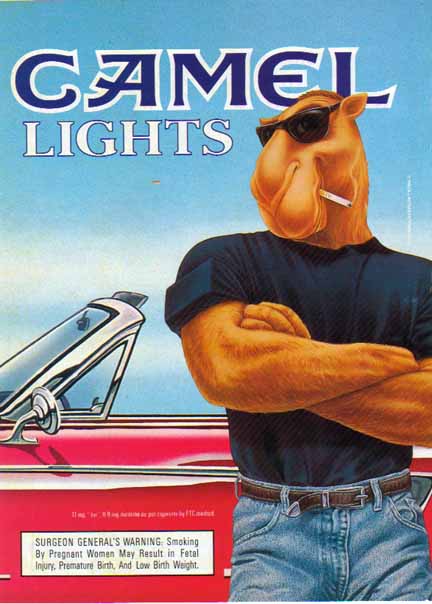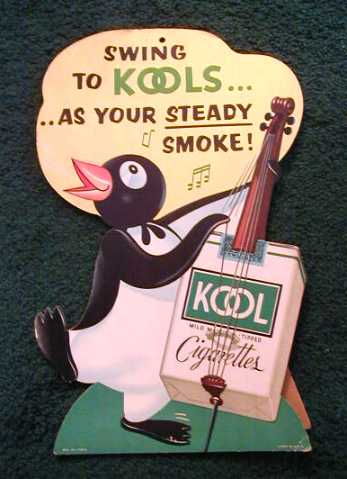 If you ever needed proof that we're fighting the wrong battles, look no further than the late 90s Joe Camel controversy. It's not that these moral crusaders didn't have good intentions, for no doubt they meant well. However, in their fixation on a single cartoon product spokescamel, they began to focus on symptom's of society's ills instead of the root cause. "If we could just get that blasted camel off of Playboy back covers," they thought, "No child will ever feel inclined to pick up a cigarette again."
If you ever needed proof that we're fighting the wrong battles, look no further than the late 90s Joe Camel controversy. It's not that these moral crusaders didn't have good intentions, for no doubt they meant well. However, in their fixation on a single cartoon product spokescamel, they began to focus on symptom's of society's ills instead of the root cause. "If we could just get that blasted camel off of Playboy back covers," they thought, "No child will ever feel inclined to pick up a cigarette again."Unfortunately for these folks, being The Man in telling the younger generation how to behave is probably the worst way to get them to acquiesce. In fact, the way most of us find out what's cool is by seeing what The Man brings down. That's not to say I'm calling cigarette smoking cool, of course. I'm no Joe Camel. That cartoon was one smooth character.
If nothing else, this media crusade only reasserts how uptight Americans are. This is what we do. We see that there are many problems that can not be fixed. Instead of picking a problem to focus on, we pick a tiny aspect of that problem from which to launch a media maelstrom of outrage and discontent. What can we say? We were too lazy to take a swing a solving the problem of youth smoking, so we cast out our excessive anger dart and target whichever minuscule point the dart pin pricks.
Admittedly I'm being a tad facetious. The Joe Camel ads, while certainly not as detrimental to society as moral watchdog groups would claim, absolutely came with myriad of mixed messages. The original Joe Camel ads (commemorating the company's 75th anniversary) featured the tagline, "75 Years and Still Smokin'". Perhaps this isn't the most welcome complement to anti-smoking programs in schools warning of emphysema and lung disease, but then again the ad isn't claiming that after 75 years you'll still be smoking. It's all in the semantics, you see.
Though the first to come under fire (from the media, that is, not lighters), Joe Camel was certainly not the only cartoon smokesanimal. From the 1930s through early 60s, Kool cigarettes had an adorable little anthropomorphic penguin hawking their goods.

A closer look into the Joe Camel Campaign shows it's pretty unlikely these ads were somehow intentionally aimed at children. A 1991 New York Times article explains
He has a penchant for dressing up in stereotypical masculine gear like hard hats, T-shirts, skin-diving wet suits and tuxedos -- all meant to appeal to the male smokers who predominate among Camel customers.
First of all, that sentence is ridiculous. It implies all real men go around alternating between their hardhats and tuxedos before a quick scuba diving jaunt. Obviously on all sides of the Joe Camel argument, serious amounts of exaggeration were in play.

The article also suggests that critics wanted to, er, penalize the character for its supposedly inappropriate traits:
Among the most contentious aspects of Joe Camel's appearance has been that nose. Reynolds has always said this protuberance is nothing more than an exaggerated rendering of a camel's nose; critics say it was drawn in a phallic fashion to suggest that smoking is a virile pursuit.
I have to say I'd never heard that one before, but my God, these people are Freudian. Okay, let's break this down. We've got a penis-nosed camel wearing sunglasses and a tuxedo, surrounded by fawning beautiful women, and proclaiming himself to be a "smooth character". This doesn't sound much like something to appeal to ignorant and impressionable young children. It sounds like something to appeal to ignorant and impressionable young men.
In all likelihood, the actual intent of the campaign was to be edgy and hip in a seriously calculated way. Sure, it's certainly an offense, but it doesn't mean they're trying to stuff cigs into the unsuspecting mouths of 3-year olds. Apparently not everyone felt this way. In this Bill Maher clip, an oddly mismatched group of interviewees discuss the controversial cartoon camel:
Regardless of Baptist Minister Tony Campolo's accusations against Camel, I beg to argue comic Kevin Nealon says it best in this segment: "If they influence kids, then why aren't more kids, like, riding camels?" Hmm. Probing question, favorite Weekend Update host. Why weren't more kids, like, riding camels?
The Journal of the American Medical Association stepped in and dealt the final blow to the thriving Joe Camel campaign. They produced a study that claimed that more kindergartners could recognize the Joe Camel character than Mickey Mouse or Fred Flintstone. First of all, that's really great news for these ad people. Secondly, maybe these researchers should have chosen some more contemporary characters.
The whole affair exploded in a highly-publicized trial, as testimonials claimed that the company was targeting young people because they were the most viable consumers with the most potential for growth. Well, as we said in the 90s, duh. That's how advertising works. We advertise to the people who will maximize our profit margins. It's not exactly rocket science.

Under pressure, the company pulled the ads, paid some money for anti-smoking campaigns, and replaced their spokescamel with a decidedly less cute generic camel silhouette. It just goes to show you: if you make a big enough fuss about some misguided notion, you can use a great deal of time, money, and effort formulating vicious allegations against a supposed wrong-doer and eventually bringing them down. Apparently a great victory for the moral crusaders of the world, the suave Joe Camel character was permanently benched. Thank God for that, too. We wouldn't want our kids exposed to obscene phallic-nosed caricatures.
Yes, I acknowledge that cigarette companies do a whole lot of wrong. That point is relatively moot. I just don't think that producing a suave hardhatted camel is one of them. Unlike today's more direct and effective anti-smoking campaigns, this didn't focus on stopping kids from smoking; instead, it sought to eliminate a character that children may potentially find appealing that could eventually lead to their interest in smoking. Not exactly a direct route there, is it?






0 comments:
Post a Comment